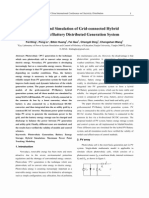MATLAB/Simulink Model of Solar PV Module and MPPT Algorithm: Kinal Kachhiya Makarand Lokhande
MATLAB/Simulink Model of Solar PV Module and MPPT Algorithm: Kinal Kachhiya Makarand Lokhande
Uploaded by
Somil AgarwalCopyright:
Available Formats
MATLAB/Simulink Model of Solar PV Module and MPPT Algorithm: Kinal Kachhiya Makarand Lokhande
MATLAB/Simulink Model of Solar PV Module and MPPT Algorithm: Kinal Kachhiya Makarand Lokhande
Uploaded by
Somil AgarwalOriginal Title
Copyright
Available Formats
Share this document
Did you find this document useful?
Is this content inappropriate?
Copyright:
Available Formats
MATLAB/Simulink Model of Solar PV Module and MPPT Algorithm: Kinal Kachhiya Makarand Lokhande
MATLAB/Simulink Model of Solar PV Module and MPPT Algorithm: Kinal Kachhiya Makarand Lokhande
Uploaded by
Somil AgarwalCopyright:
Available Formats
National Conference on Recent Trends in Engineering & Technology
MATLAB/Simulink Model of Solar PV Module and MPPT Algorithm
Kinal Kachhiya
P.G. Student, 4th Semester M.E. Electrical, Sankalchand Patel College of Engineering, Visnagar, Gujarat, India. kachhiyakinal@gmail.com
Makarand Lokhande
Asst. Professor, School of Solar Energy, PDPU, Raisan-382007, Gandhinagar, Gujarat, India. makarand.lokhande@sse.pdpu.ac.in
Mukesh Patel
Asst. Professor & Head, Electrical Engg. Dept., Sankalchand Patel College of Engineering, Visnagar, Gujarat, India. profmrpatel@gmail.com
AbstractThe paper presents the simulation of the BP SX150S Solar Photovoltaic module using Matlab Simulink. The I-V & PV characteristics are obtained for various values of solar insolation keeping the cell temperature constant. The Maximum Power Point Tracking (MPPT) algorithm, which is based on the incremental conductance method, is also described. The P-V characteristics are obtained for various insolations using M-file showing MPP using Incremental conductance method. Also, the points indicating Module voltage Vmp and Current Imp at maximum power Pmax are obtained.
Keywords Photovoltaic modules, MPPT, Matlab/Simulink, insolation, Incremental conductance Method I. INTRODUCTION
The entire world is facing a challenge to overcome the hurdle of energy crisis. The diminishing deposits of non renewable energy resources such as coal, natural gas, fossil fuels etc. have added to this worry. It is thus fairly evident that a need exist for developing alternative energy sources. The immediate need would be to vitiate the problems caused by depletion of oil and natural gas, while the long term need would be to develop means that can replace coal and fossil fuels. Rapid population growth and industrialization, demands for an increased amount of electrical energy. Solar energy is a renewable, inexhaustible and ultimate source of energy. If used in a proper way, it has a capacity to fulfil numerous energy needs of the world. The power from the sun intercepted by earth is approximately 1.8 x 1011MW [1].This figure, being thousands of time larger than the present consumption rate enables more and more research in the field of solar energy so that the present and future energy needs of the world can be met. Thus Even though the PV system is posed to its high capital fabrication cost and low conversion efficiency, the skyrocketing oil prices make solar energy naturally viable energy supply with potentially long-term benefits. PV module represents the fundamental power conversion unit of a PV generator system. The output characteristics of
PV module depends on the solar insolation, the cell temperature and output voltage of PV module. Since PV module has nonlinear characteristics, it is necessary to model it for the design and simulation of maximum power point tracking (MPPT) for PV system applications. The mathematical PV models used in computer simulation have been built. [2]- [3]. Almost all well-developed PV models describe the output characteristics mainly affected by the solar insolation, cell temperature, and load voltage. Recently, a number of powerful component-based electronics simulation software package have become popular in the design and development of power electronics applications. However, the Sim Power System tool in Matlab/Simulink package offers wind turbine models but no PV model to integrate with current electronics simulation technology. Thus, it is difficult to simulate and analyse in the generic modelling of PV power system. This motivates me to develop a model for PV cell, module, and array using Matlab/Simulink. However, the solar energy is a dilute source of energy and its availability varies widely with time. So, it is very necessary to make a complete utilization of solar energy in available time. Many maximum power point tracking algorithms are available for a solar panel in order to produce maximum output. It is very necessary that it is operated consistently at the maximum power point. The Incremental Conductance Method of MPPT is described here with its maximum power point. II. PHOTOVOLTAIC MODULE AND ARRAY MODEL
Solar cell is basically a p-n junction fabricated in a thin wafer or layer of semiconductor. The electromagnetic radiation of solar energy can be directly converted to electricity through photovoltaic effect. Being exposed to the sunlight, photons with energy greater than the band-gap energy of the semiconductor are absorbed and create some electron-hole pairs proportional to the incident irradiation. Under the influence of the internal electric fields of the p-n junction, these carriers are swept apart and create a photocurrent which is directly proportional to solar insolation.
13-14 May 2011
B.V.M. Engineering College, V.V.Nagar,Gujarat,India
National Conference on Recent Trends in Engineering & Technology
PV system naturally exhibits a nonlinear I I-V and P-V characteristics which vary with the radiant intensity and cell temperature. Fig. 1 shows the equivalent circuit models of PV cell. Since a typical PV cell produces less than 2W at 0.5V approximately, the cells must be connected in series series-parallel configuration on a module to produce enough high power. A PV array is a group of several PV modules which are electrically connected in series and parallel circuits to generate d the required current and voltage. The equivalent circuit for the solar module arranged in NP parallel and NS series is shown in Fig. 2. The terminal equation for the current and voltage of the array becomes as follows [5]-[8]. All of the model parameters can be determined by examining the manufacturers specifications of PV products. The most important parameters widely used for describing the cell electrical performance is the open open-circuit voltage VOC and the short-circuit current ISC The aforementioned SC. equations are implicit and nonlinear; therefore, it is difficult to arrive at an analytical solution for a set of model parameters at a specific temperature and irradiance.
q ( V / N S + IR S ) / N P ) I = N P I PH N P IS exp 1 kTC A
(1) where, IPH is a light-generated current or photocurrent, IS is generated the cell saturation of dark current, q (= 1.6 10 19C) is an electron charge, k (= 1.38 10 23J/K) is a Boltzmanns constant, TC is the cells working temperature, A is an ideal rking factor, RSH is a shunt resistance, and RS is a series resistance. The photocurrent mainly depends on the solar insolation and cells working temperature, which is described as (2) where ISC is the cells short-circuit current at a 25 C and circuit 1kW/m2, KI is the cells short-circuit current temperature rent coefficient, TRef is the cells reference temperature, and is the solar insolation in kW/m2. On the other hand, the cells saturation current varies with the cell temperature, which is ries described as 1 1 qEG ( ) Tref TC I S = I RS (TC / Tref )3 exp[ ] kA (3) where IRS is the cells reverse saturation current at a reference temperature and a solar radiation ,EG is the bang bang-gap energy of the semiconductor used in the cell. The ideal factor A is dependent on PV technology [4] and is listed in Table I. ]
TABLE I FACTOR A DEPENDENCE ON PV TECHNOLOGY [9]
(N P V / N S + IR S ) / R SH
Fig. 1 Equivalent circuit model of PV cell
IPH = [ISC + K I ( TC Tref )]
13-14 May 2011
B.V.M. Engineering College, V.V.Nagar,Gujarat,India
Technology Si Mono Si-Poly a-Si:H a-Si:H tandem a-Si:H triple CdTe CTS AsGa
A 1.2 13 18 3.3 5 1.5 1.5 13
Fig. 2 Equivalent circuit model of generalized PV
Since normally IPH >> IS and ignoring the small diode and nd ground-leakage currents under zero-terminal voltage, the leakage zero short-circuit current ISC is approximately equal to the photocurrent IPH , i.e.,
IPH = ISC
(1) On the other hand, the VOC parameter is obtained by assuming the output current is zero. Given the PV open open-circuit voltage VOC at reference temperature and ignoring the shunt shuntleakage current, the reverse saturation current at reference temperature can be approximately obtained as
qVOC I RS = ISC / exp 1 NS kTC A
(5) In addition, the maximum power can be expressed as
Pmax = Vmax I max = VOC ISC
(6) where Vmax and Imax are terminal voltage and output current of PV module at maximum power point (MPP), and cell fill factor which is a measure of cell quality. is the
National Conference on Recent Trends in Engineering & Technology
III. SIMULATION OF SOLAR PV MODULE IN MATLAB
In this section the characteristic equations (1), (2), (3) & (5) for the PV module is implemented in MatLab Simulink as shown in Fig. 3. The parameters chosen for modeling corresponds to the BP SX150S module as listed in Table II. The voltage V is considered varying from 0 to open circuit voltage Voc corresponding to the variation in current from short circuit current Isc to 0. Fig.4 & 5 shows the V-I & P-V characteristics V with the variation in solar insolation level at a constant cell temperature of 25 degrees respectively. It can be seen that the short circuit current as well as the power increases with the increase in insolation level, while very little change in the open-circuit voltage. The peak value of the product of V and I represent the maximum power point (MPP) Pmax of the solar module. The current and voltage of PV module at the MPP are denoted by Imp and Vmp, respectively. The solar module should always be operated in this region so as to extract the maximum power for a given input conditions. For this purpose various maximum power point algorithms can be used.
TABLE II PARAMETERS OF BP SX150S SOLAR MODULE Fig.5 P-V Characteristics for different insolation V
Fig.4 V-I Characteristics for different insolation I
Parameter Maximum Power (Pmax) Voltage at Pmax (Vmp) Current at Pmax (Imp) Warranted minimum Pmax Short circuit current (I sc ) Open-circuit voltage (Voc) Maximum System Voltage Temp. Co-efficient of Isc Temp. Co-efficient of Voc Temp. Co-efficient of Power NOCT
Value 150 W 34.5 V 4.35 A 140 W 4.75 A 5 43.5 V 600 V (0.065+-0.015)%/C 0.015)%/C 20) -(160+-20) mv/C -(0.5+-0.05) %/C 0.05) 47+-2 0C
IV.
MAXIMUM POWER POINT TRACKING
Fig. 3 Matlab Simulation of PV Module
The output power of the solar PV module changes with change in direction of the sun, change in solar insolation level and change in temperature. Also there is a single maximum power point in the PV characteristics of the PV module for a particular operating condition. It is desired that the PV module operates close to this point, i.e., output of the PV module es approaches near to MPP. The process of operating PV module at this condition is called as maximum power point tracking (MPPT). Maximization of PV power improves the utilization of the solar PV module.[11] Many MPPT algorithms had been proposed in the past. Two comparatives between them are included in the works presented in [8]. The most common algorithms nowadays are ]. the P& O and the incremental conductance method [ Also [8]. the Hill climbing method is described in [10]. [10].The Incremental conductance method offers the main advantage of providing high efficiency under rapidly changing atmospheric conditions, so it has been employed in the proposed model. Nevertheless another MPPT algorithm could be used if i was required in it the simulations. The MPPT implemented algorithm is depicted in Fig. 6. The algorithm basis is the PV array output current, which is constantly adjusted to reach the voltage in the maximum power point (MPP). Fig. 7 shows the P-V characteristic for the BP SX150S module obtained using incremental conductance X150S method. The Algorithm is implemented using M M-file in MATLAB. Fig. 8 and Fig. 9 show the module voltage Vmp and Current Imp at the maximum power Pmax .
13-14 May 2011
B.V.M. Engineering College, V.V.Nagar,Gujarat,India
National Conference on Recent Trends in Engineering & Technology
Fig. 9 Module Current at Maximum Power, Imp
V.
CONCLUSIONS
Fig. 6 Incremental conductance Method [12] ductance
The I-V and P-V characteristics of BP SX150S solar V module are obtained using the MATLAB/Simulink for different values of insolations. The P- characteristics are also -V obtained using the M-file with Incremental Conductance file method. It is observed that the characteristics obtained using both methods are matching with the theoretical C Characteristics. Also the module voltage Vmp and Current Imp at the maximum power Pmax are obtained which are fairly same as indicated by the manufacturer of BP SX150S solar panel. Thus the X150S proposed simulation model in conjunction with MPPT algorithm can be used with DC-DC Boost converter to obtain DC the required dc voltage to supply the dc load. ACKNOWLEDGMENT The authors would like to thank Prof. Jatin Patel and Prof. ike Makarand Lokhande of School of Petroleum Technology, Pandit Deendayal Petroleum University Gandhinagar, Gujarat, University, India and Prof. K. B. Shah of Sankalchand patel college of Engineering, Visnagar, Gujarat, India for their valuable , contribution to this paper. REFERENCES
[1] [2] R. Messenger and J. Ventre, Photovoltaic Systems Engineering, CRC Press, 2000, pp.41-51. S. W. Angrist, , Direct Energy Conversion, Allyn and Bacon, Inc., 4th edition, 1982, pp. 177-227. O. Wasynczuk, Dynamic behavior of a class of photovoltaic power systems, IEEE Transactions on Power Apparatus and Systems, vol. PAS-102, no. 9, 1983, pp. 3031-3037. C. C. Hua and C. M. Shen, Study of maximum power tracking techniques and control of dc-dc converters for photovoltaic power dc system, Proceedings of 29th annual IEEE Power Electronics Specialists Conference, vol. 1, 1998, pp. 86-93. M. Veerachary and K.S. Shinoy, V2 V2-based power tracking for nonlinear PV sources, IEE Proceedings-Electric Power Applications, Proceedings vol. 152, no. 5, 2005, pp. 1263-1270. I. S. Kim and M. J. Youn, Variable-structure observer for solar array structure current estimation in a photovoltaic power-generation system, IEE power Proceedings-Electric Power Applications, vol. 152, no. 4, 2005, pp. 953Electric 953 959. I. S. Kim, M. B. Kim, and M. J. Youn, New maximum power point tracker using sliding-mode observer for estimation of solar array cu mode current in the grid-connected photovoltaic system, IEEE Transaction on connected Industrial Electronics, vol. 53, no. 4, 2006, pp. 1027 1027-1035.
Fig. 7 PV curve for Incremental conductance Method
[3]
[4]
[5]
[6]
[7] Fig. 8 Module Voltage at Maximum Power, Vmp
13-14 May 2011
B.V.M. Engineering College, V.V.Nagar,Gujarat,India
National Conference on Recent Trends in Engineering & Technology
[8] K. H. Hussein, I. Muta, T. Hoshino, and M. Osakada, Maximum photovoltaic power tracking: an algorithm for rapidly changing atmospheric conditions, IEE Proceedings of Generation, Transmission and Distribution, vol. 142, no. 1, 2005, pp. 953-959. [9] Huan-Liang Tsai, Ci-Siang Tu, and Yi-Jie Su, Development of Generalized Photovoltaic Model Using MATLAB/SIMULINK, Proceedings of the World Congress on Engineering and Computer Science 2008, October 22 - 24, 2008, San Francisco, USA [10] C. Gonzlez-Morn, P. Arboleya, D. Reigosa, G. Daz, J. GmezAleixandre Improved model of photovoltaic sources considering ambient temperature and solar Irradiation Principado de Asturias government (PCTI 2006-2009) under grant BP06-165, February 16, 2009. [11] Rajesh Gupta, Gaurang Gupta, Dharmendra Kastwar, Amir Hussain and Hars Ranjan, Modeling and Design of MPPT Controller for a PV Module using PSCAD/EMTDC , M.N.National Institute of Technology, Allahabad-211004, India. [12] Rakesh A. Patel, Design and Implementation of Single phase Grid connected Photovoltaic Inverter using DSP, Nirma University of Science and Technology, Ahmedabad, May 2008.
13-14 May 2011
B.V.M. Engineering College, V.V.Nagar,Gujarat,India
You might also like
- EE100B Lab ReportDocument7 pagesEE100B Lab ReportTina NguyenNo ratings yet
- Modeling and Control of DC-DC Boost Converter Using K-Factor Control For MPPT of Solar PV SystemDocument6 pagesModeling and Control of DC-DC Boost Converter Using K-Factor Control For MPPT of Solar PV SystemHoang ManhNo ratings yet
- Extraction of The Internal Parameters of Solar Photovoltaic Module by Developing Matlab / Simulink Based ModelDocument5 pagesExtraction of The Internal Parameters of Solar Photovoltaic Module by Developing Matlab / Simulink Based Modelzameer05090% (1)
- Modeling and Simulation of Photovoltaic Module Using MATLAB SimulinkDocument6 pagesModeling and Simulation of Photovoltaic Module Using MATLAB SimulinkpraveeneeeNo ratings yet
- (ART) A Photovoltaic System Model For Matlab Simulink PDFDocument5 pages(ART) A Photovoltaic System Model For Matlab Simulink PDFMustapha El MetouiNo ratings yet
- Paper PV Model MPP EEE 2012Document12 pagesPaper PV Model MPP EEE 2012Nur MohammadNo ratings yet
- Analysis The Performance of PV System To Get Maximum Energy Under Different Environmental ConditionDocument21 pagesAnalysis The Performance of PV System To Get Maximum Energy Under Different Environmental ConditionrajNo ratings yet
- Soft Switching Buck Converter For Battery Charging With MPPTDocument7 pagesSoft Switching Buck Converter For Battery Charging With MPPTVenkanna BodigeNo ratings yet
- Modeling and Design of MPPT Controller For A PV Module Using PSCAD/EMTDCDocument7 pagesModeling and Design of MPPT Controller For A PV Module Using PSCAD/EMTDCGaurang GuptaNo ratings yet
- Modeling and Simulation of Solar PV Module For ComDocument12 pagesModeling and Simulation of Solar PV Module For ComLayth ZubairiNo ratings yet
- Modelling, Simulation and Control of Utility Grid Integrated Solar Photovoltaic System Using MatlabDocument10 pagesModelling, Simulation and Control of Utility Grid Integrated Solar Photovoltaic System Using MatlabInternational Journal of Application or Innovation in Engineering & ManagementNo ratings yet
- Extraction of Maximum Power From A Solar PV System Using Fuzzy Controller Based MPPT TechniqueDocument6 pagesExtraction of Maximum Power From A Solar PV System Using Fuzzy Controller Based MPPT Techniquesaeed ebrahimiNo ratings yet
- 02 Nvee10089Document8 pages02 Nvee10089Edu Daryl MacerenNo ratings yet
- MPPT AlgorithmDocument7 pagesMPPT AlgorithmVishnu Kumar NadarNo ratings yet
- Solar PVDocument8 pagesSolar PVmurthy237No ratings yet
- Article 17 Ijaet Volii Issue IV Oct Dec 2011Document10 pagesArticle 17 Ijaet Volii Issue IV Oct Dec 2011Mustapha Maiz Hadj AhmedNo ratings yet
- International Journal of Engineering Research and DevelopmentDocument8 pagesInternational Journal of Engineering Research and DevelopmentIJERDNo ratings yet
- Incremental Conductance MPPT Method For PV Systems-LibreDocument3 pagesIncremental Conductance MPPT Method For PV Systems-LibreRushikeshKatkarNo ratings yet
- 82Document7 pages82Singam SridharNo ratings yet
- Modeling and Simulation of PV Array and Its Performance Enhancement Using MPPT (P&O) TechniqueDocument8 pagesModeling and Simulation of PV Array and Its Performance Enhancement Using MPPT (P&O) Techniqueeditor9891No ratings yet
- IF2214201424Document5 pagesIF2214201424muthukumartharaniNo ratings yet
- Project ReportsDocument45 pagesProject ReportsRahuNo ratings yet
- A Comparative Study of PV Models in Matlab/SimulinkDocument6 pagesA Comparative Study of PV Models in Matlab/SimulinkJaime Zapata AmoresNo ratings yet
- Ajassp.2010.682.691 ImpDocument10 pagesAjassp.2010.682.691 ImpulaganathanNo ratings yet
- A Project Report OnDocument17 pagesA Project Report OnAshok GadhwalNo ratings yet
- Publication 1Document4 pagesPublication 1Mahamudul HasanNo ratings yet
- Effects of Loads Solar PVDocument14 pagesEffects of Loads Solar PVdabigi2426No ratings yet
- MATLAB Based Modelling of Solar Photovoltaic Cell: A Project OnDocument25 pagesMATLAB Based Modelling of Solar Photovoltaic Cell: A Project OnRajat Agrawal100% (1)
- Perturb and Observe Method MATLAB Simulink and Design of PV System Using Buck Boost ConverterDocument5 pagesPerturb and Observe Method MATLAB Simulink and Design of PV System Using Buck Boost ConverterGss ChaitanyaNo ratings yet
- Comparison of PV Panels MPPT Techniques Applied To Solar Water Pumping SystemDocument10 pagesComparison of PV Panels MPPT Techniques Applied To Solar Water Pumping SystemInternational Journal of Power Electronics and Drive SystemsNo ratings yet
- A Step by Step Technique For Using SimulDocument10 pagesA Step by Step Technique For Using SimulhajasoftwareNo ratings yet
- Comparative Study of P&O and Inc MPPT AlgorithmsDocument7 pagesComparative Study of P&O and Inc MPPT AlgorithmsAJER JOURNALNo ratings yet
- 117 1014 1 PBDocument9 pages117 1014 1 PBChithrailingam PerumalNo ratings yet
- Solar Energy Conversion Systemwith Maximum Power Point TrackingDocument7 pagesSolar Energy Conversion Systemwith Maximum Power Point Trackingshahid.msee187No ratings yet
- A Seven Level Inverter Using A Solar Power Generation SystemDocument7 pagesA Seven Level Inverter Using A Solar Power Generation Systemsasitharan33No ratings yet
- 14sepicconferencepaper PDFDocument6 pages14sepicconferencepaper PDFSherrinNo ratings yet
- Modeling and Circuit-Based Simulation of Photovoltaic ArraysDocument11 pagesModeling and Circuit-Based Simulation of Photovoltaic ArraysnavidelecNo ratings yet
- (Doi 10.1109/ICMCS.2011.5945712) Amatoul, Fatima Zahra Lamchich, Moulay Tahar Outzourhit, Abdel - (IEEE 2011 International Conference On Multimedia Computing and Systems (ICMCS) - Ouarzazate, MorDocument6 pages(Doi 10.1109/ICMCS.2011.5945712) Amatoul, Fatima Zahra Lamchich, Moulay Tahar Outzourhit, Abdel - (IEEE 2011 International Conference On Multimedia Computing and Systems (ICMCS) - Ouarzazate, MorDiego Quintana ValenzuelaNo ratings yet
- Fig-II.1 (A) - Schematic Diagram of The PV SystemDocument3 pagesFig-II.1 (A) - Schematic Diagram of The PV SystemAditi MishraNo ratings yet
- Mrs. Kapil Parikh Mahavir Singh: Supervisor Submitted byDocument27 pagesMrs. Kapil Parikh Mahavir Singh: Supervisor Submitted byMahavir SinghNo ratings yet
- Modeling and SimulationDocument4 pagesModeling and Simulationdoud98No ratings yet
- A Maximum Power Point Tracking Technique For Partially Shaded Photovoltaic Systems in MicrogridsDocument11 pagesA Maximum Power Point Tracking Technique For Partially Shaded Photovoltaic Systems in MicrogridsRam KumarNo ratings yet
- Design and Simulation of A PV System With Battery Storage Using Bidirectional DC DC Converter Using Matlab Simulink PDFDocument8 pagesDesign and Simulation of A PV System With Battery Storage Using Bidirectional DC DC Converter Using Matlab Simulink PDFDobrea Marius-AlexandruNo ratings yet
- MATLAB Simulink Based Modeling of Solar PV Cell PDFDocument6 pagesMATLAB Simulink Based Modeling of Solar PV Cell PDFYuvarekha SenthilkumarNo ratings yet
- Performance Evaluation of Maximum Power Point Tracking Algorithm With Buck-Boost DC-DC Converter For Solar PV SystemDocument5 pagesPerformance Evaluation of Maximum Power Point Tracking Algorithm With Buck-Boost DC-DC Converter For Solar PV SystemIJSTENo ratings yet
- 154 Icrera2013 SpainDocument10 pages154 Icrera2013 SpainMarian EnachescuNo ratings yet
- Modelling and Simulation of Maximum Power Point TrackingDocument6 pagesModelling and Simulation of Maximum Power Point TrackingNicole GabrielNo ratings yet
- RNES Practical ReportDocument13 pagesRNES Practical ReportSandile MadunaNo ratings yet
- SIMULINK Model of PV Array With MPPT Using Cuk ConverterDocument7 pagesSIMULINK Model of PV Array With MPPT Using Cuk ConverterVishal KevatNo ratings yet
- Automatic Peak Power Tracker Using dSPACEDocument63 pagesAutomatic Peak Power Tracker Using dSPACEAkkalaAshwini100% (2)
- Microchip Inv DesignDocument56 pagesMicrochip Inv DesignKrishna SinghNo ratings yet
- Elk 21 2 1 1105 29Document8 pagesElk 21 2 1 1105 29tinhmaixatoi2006No ratings yet
- Solar Watch SimulationDocument4 pagesSolar Watch SimulationSwapNo ratings yet
- Modeling and Simulation of Grid-Connected Hybrid Photovoltaic/Battery Distributed Generation SystemDocument10 pagesModeling and Simulation of Grid-Connected Hybrid Photovoltaic/Battery Distributed Generation SystemBreno NunesNo ratings yet
- 10 1109@it48810 2020 9070299Document4 pages10 1109@it48810 2020 9070299radhikaguntupalliNo ratings yet
- CNRE Green Energy Reseach PDFDocument15 pagesCNRE Green Energy Reseach PDFNishant NagarNo ratings yet
- Grid-Integrated and Standalone Photovoltaic Distributed Generation Systems: Analysis, Design, and ControlFrom EverandGrid-Integrated and Standalone Photovoltaic Distributed Generation Systems: Analysis, Design, and ControlNo ratings yet
- Simulation of Some Power System, Control System and Power Electronics Case Studies Using Matlab and PowerWorld SimulatorFrom EverandSimulation of Some Power System, Control System and Power Electronics Case Studies Using Matlab and PowerWorld SimulatorNo ratings yet
- SGPDocument40 pagesSGPSrinivasu Raju100% (1)
- U18ec038 - Vlsi - Lab 2Document9 pagesU18ec038 - Vlsi - Lab 2Timir PatelNo ratings yet
- La 78040Document4 pagesLa 78040Wilton Carlos SilvaNo ratings yet
- Ds-N2-60-K-G-F-En-50430 (Neon 2 - All Black) - 33988 PDFDocument2 pagesDs-N2-60-K-G-F-En-50430 (Neon 2 - All Black) - 33988 PDFJohnWilliamsNo ratings yet
- Acc 24e2aDocument63 pagesAcc 24e2aCasey FordyceNo ratings yet
- ECE18R171 Electronic Devices ECE18R171 Electronic Devices: Course Objective(s)Document2 pagesECE18R171 Electronic Devices ECE18R171 Electronic Devices: Course Objective(s)Jeya Prakash KNo ratings yet
- TM 11-636 An - TRC-10Document166 pagesTM 11-636 An - TRC-10Advocate100% (1)
- TMR - TriconexDocument13 pagesTMR - TriconexWasim AhmedNo ratings yet
- Circuit Diagram of Mobile Controlled Home AppliancesDocument15 pagesCircuit Diagram of Mobile Controlled Home AppliancesSubhasreeKonarNo ratings yet
- Thyristors, Triacs, DiacsDocument5 pagesThyristors, Triacs, DiacsAnonymous n50GmJNo ratings yet
- HSPE-144M M6 HC Monofacial 450-460W Rev.00Document2 pagesHSPE-144M M6 HC Monofacial 450-460W Rev.00Alejandro Holguin QuinteroNo ratings yet
- Wave Shaping CircuitsDocument15 pagesWave Shaping CircuitsParesh SawantNo ratings yet
- Akusti̇k Mi̇kroskobi̇Document49 pagesAkusti̇k Mi̇kroskobi̇emirNo ratings yet
- Manual de Instalación1948Document2 pagesManual de Instalación1948Marcos AngelelliNo ratings yet
- May 2018 Module 3 Electrical Fundamental-1 PDFDocument6 pagesMay 2018 Module 3 Electrical Fundamental-1 PDFwasim ansariNo ratings yet
- CND101 Lab 7Document24 pagesCND101 Lab 7Mostafa KhaledNo ratings yet
- Coatings: The Use of Copper Oxide Thin Films in Gas-Sensing ApplicationsDocument19 pagesCoatings: The Use of Copper Oxide Thin Films in Gas-Sensing ApplicationsJeff SalesNo ratings yet
- Vincotech V23990 K209 A FD Rev 05Document18 pagesVincotech V23990 K209 A FD Rev 05Arthur RuedaNo ratings yet
- SRF 005Document4 pagesSRF 005David Bonfill MirallesNo ratings yet
- Znshine-Solar ZXM8-TPLDD110 DatasheetDocument2 pagesZnshine-Solar ZXM8-TPLDD110 Datasheetpradeep.sNo ratings yet
- Pafm600w 4.2Document4 pagesPafm600w 4.2Juan Enrique Castillo CanoNo ratings yet
- Chapter 3-Dielectric PropertiesDocument38 pagesChapter 3-Dielectric Propertieskanita_jaww100% (2)
- 2007-08 M.sc. ElectronicsDocument19 pages2007-08 M.sc. ElectronicsUlhasNo ratings yet
- Deutsche BankDocument10 pagesDeutsche BankSurabhi MattaNo ratings yet
- Low Power CMOS VLSI Circuit Design by Kaushik RoyDocument374 pagesLow Power CMOS VLSI Circuit Design by Kaushik RoyJasper Jeny86% (29)
- Address DecodingDocument11 pagesAddress DecodingAunas ManzoorNo ratings yet
- Analog Sensors PDFDocument110 pagesAnalog Sensors PDFakozyNo ratings yet
- Welding Electrode ClassificationsDocument2 pagesWelding Electrode ClassificationsKarthi KeyanNo ratings yet
- Data Sheet: HEF40174B MSIDocument6 pagesData Sheet: HEF40174B MSIPedroZevallosNo ratings yet

























































































